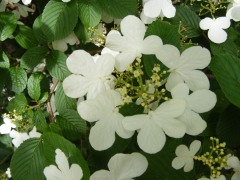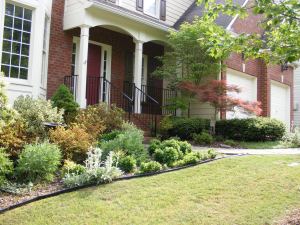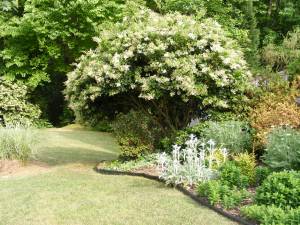Gardening can be an expensive hobby with buckets, watering cans, and shovels to buy. By the time you have invested in a few good tools, you find you have very little money to spend on plants. A great way to save money on plants is propagating what you already have in your landscape. Especially if you have a plant that you think is really terrific and you want more of it. It is by far the best way to save money in the garden and a lot of fun to boot. And if you have children, it’s great to get them in on the act, too. My 9 year old son has been gardening with me since he was a toddler.
There is nothing like planting a shrub that you have started from a cutting, nurtured, and then planted in the garden. The simple act of pruning a shrub to maintain size or shape can provide you with plenty of shoots to root for cuttings. Unfortunately, the more difficult a plant is to propagate, the more expensive it is in the nursery. Luckily, the majority of shrubs are easy to root from cuttings and this is the subject I will cover here.
Types of Cuttings: Soft, Half-ripe, and Hard
 Cuttings are the most commonly used method for increasing shrubs. There are three different types of cuttings you can take from your shrub: soft cuttings, half-ripe cuttings, and hardwood cuttings. Many gardening books and manuals will often tell you touse one type of cutting for one type of shrub and another type of cutting for another type of shrub. In all honesty, this does not always work that way. I have taken many different types of cuttings from a plant, been successful with some and then tried to duplicate my process the following year only to fail miserably. My best advice is to try soft cuttings first, then half-ripe and finally hardwood cuttings and judge for yourself which is working best. A pot containing a dry, dead stick or a mass of green mush will tell you how well you’re doing. And by the way – experiment – that’s how to become a good gardener. Experiment and fail and learn from your mistakes. Many famous and legendary gardening gurus when interviewed have said the secret to their success has been that through their failed experiments they have learned to more closely observe the plant – its needs and temperament.
Cuttings are the most commonly used method for increasing shrubs. There are three different types of cuttings you can take from your shrub: soft cuttings, half-ripe cuttings, and hardwood cuttings. Many gardening books and manuals will often tell you touse one type of cutting for one type of shrub and another type of cutting for another type of shrub. In all honesty, this does not always work that way. I have taken many different types of cuttings from a plant, been successful with some and then tried to duplicate my process the following year only to fail miserably. My best advice is to try soft cuttings first, then half-ripe and finally hardwood cuttings and judge for yourself which is working best. A pot containing a dry, dead stick or a mass of green mush will tell you how well you’re doing. And by the way – experiment – that’s how to become a good gardener. Experiment and fail and learn from your mistakes. Many famous and legendary gardening gurus when interviewed have said the secret to their success has been that through their failed experiments they have learned to more closely observe the plant – its needs and temperament.
Soft Cuttings
 These are cuttings taken from the growing tips of the branches and trimmed just below a node (a node is the point at which leaves occur on the shoot). The best time to take soft cuttings is during late spring and early summer. If success is achieved and roots form, you could have a well-established plant by autumn. The easiest way of taking the cutting is to remove it from the parent plant by cutting it off with hand clippers. Select a shoot 3-8 inches long. Clip the branch off just above a set of leaves. This allows the shrub to continue making future shoots from this cut area. Then take your cutting and trim the branch off just below a leaf node. Discard this bit. Next remove all leaves from bottom 2/3 of shoot. I sometimes leave only a couple of leaves on the top of the shoot for photosynthesis purposes. The bottom one inch of the cutting can then be dipped in rooting hormone. Studies have shown an excess of rooting hormone can actually retard the rooting process so use only a very small amount. I have two small children toddling around my potting bench so I choose to not use any chemical rooting helpers. My rate of propagation is probably not as high as it could be, but my children and I are not breathing in anything potentially harmful.
These are cuttings taken from the growing tips of the branches and trimmed just below a node (a node is the point at which leaves occur on the shoot). The best time to take soft cuttings is during late spring and early summer. If success is achieved and roots form, you could have a well-established plant by autumn. The easiest way of taking the cutting is to remove it from the parent plant by cutting it off with hand clippers. Select a shoot 3-8 inches long. Clip the branch off just above a set of leaves. This allows the shrub to continue making future shoots from this cut area. Then take your cutting and trim the branch off just below a leaf node. Discard this bit. Next remove all leaves from bottom 2/3 of shoot. I sometimes leave only a couple of leaves on the top of the shoot for photosynthesis purposes. The bottom one inch of the cutting can then be dipped in rooting hormone. Studies have shown an excess of rooting hormone can actually retard the rooting process so use only a very small amount. I have two small children toddling around my potting bench so I choose to not use any chemical rooting helpers. My rate of propagation is probably not as high as it could be, but my children and I are not breathing in anything potentially harmful.
 After you have prepared the shoot, insert it into a small pot of potting soil. First, make a deep hole in the soil with a pencil or your finger, then insert the shoot. Only bury half of the shoot in the soil. It is important that the bottom of the cutting be in contact with the soil. Firm it in by inserting your finger or pencil to the side of the cutting and pack the soil around it. A mixture of potting soil heavy on Perlite will work well in rooting cuttings. I add a heavy dose of sand to the soil which can also help.
After you have prepared the shoot, insert it into a small pot of potting soil. First, make a deep hole in the soil with a pencil or your finger, then insert the shoot. Only bury half of the shoot in the soil. It is important that the bottom of the cutting be in contact with the soil. Firm it in by inserting your finger or pencil to the side of the cutting and pack the soil around it. A mixture of potting soil heavy on Perlite will work well in rooting cuttings. I add a heavy dose of sand to the soil which can also help.
The problem with soft cuttings is just that – they are soft and delicate and prone to wilt. To prevent this it needs to be kept in humid conditions. A clear, plastic bag covering the pot works well to keep in moisture. Be sure to support the bag off of the shoot with sticks poked in around the edges of the pot. Without plastic, I have arranged cuttings in their pots under a big leaved shrub. It tends to be moist, shady, and humid under there and can work well to protect them. I am currently housing five or six cuttings under a large hydrangea bush and they all seem to be doing rather well.
Check the cuttings regularly. If any show signs of rot, remove them from the other potential cuttings and discard. The cuttings may root in as little as a few weeks or may take a couple of months. Some may not be well-rooted until spring the following year.
Half-ripe Cuttings
Half-ripe cuttings are taken between early summer and early autumn. This type of cutting is generally easier to root than soft cuttings. They are much less likely to wilt. Although the bottom of the cutting is stronger the growing tip is still soft and delicate. Take these cuttings from the parent plant exactly the same way as in soft cuttings. Prepare the shoot, trim it up, and use hormone powder if desired. However, these cuttings do not need as much warmth and humidity as softwood cuttings. They can be placed on a bench in the shade.
Hardwood Cuttings
These are the easiest of all cuttings to root. Take these when the leaves have fallen, using current seasons growth which is ripe and woody. Cut these branches 6-12 inches long and discard the soft tip part of the branch. The top cut you will make needs to be just above a dormant node and the bottom cut just below a dormant node. Prepare a pot with potting soil, as before, and insert cutting. Keep this in a sheltered spot and by late spring or late summer you should have a well-rooting cutting.
Beautiful New Shrubs
 When you start, remember rooting plants from cuttings is easy. I have a lovely new hydrangea all thanks to my husband and his paint brush. While painting the trim on our house, my husband hacked at a hydrangea branch that was in his way. After being handed the sad, tattered shoot I frowned at him. My husband is a wonderful man but in no way a gardener. I took the shoot, trimmed it up, and prepared it in a pot of compost. If it didn’t root, I would not have been upset. In fact, I was so busy I didn’t really check on it for a month or more. The happy end of my story is I planted a beautiful new hydrangea in another area of my garden. Don’t be afraid to experiment. Have fun gardening!
When you start, remember rooting plants from cuttings is easy. I have a lovely new hydrangea all thanks to my husband and his paint brush. While painting the trim on our house, my husband hacked at a hydrangea branch that was in his way. After being handed the sad, tattered shoot I frowned at him. My husband is a wonderful man but in no way a gardener. I took the shoot, trimmed it up, and prepared it in a pot of compost. If it didn’t root, I would not have been upset. In fact, I was so busy I didn’t really check on it for a month or more. The happy end of my story is I planted a beautiful new hydrangea in another area of my garden. Don’t be afraid to experiment. Have fun gardening!
Have any questions? Please contact me.

 The following is a short list of other ideas for hedging material. I tried to think outside of the box.
The following is a short list of other ideas for hedging material. I tried to think outside of the box.















